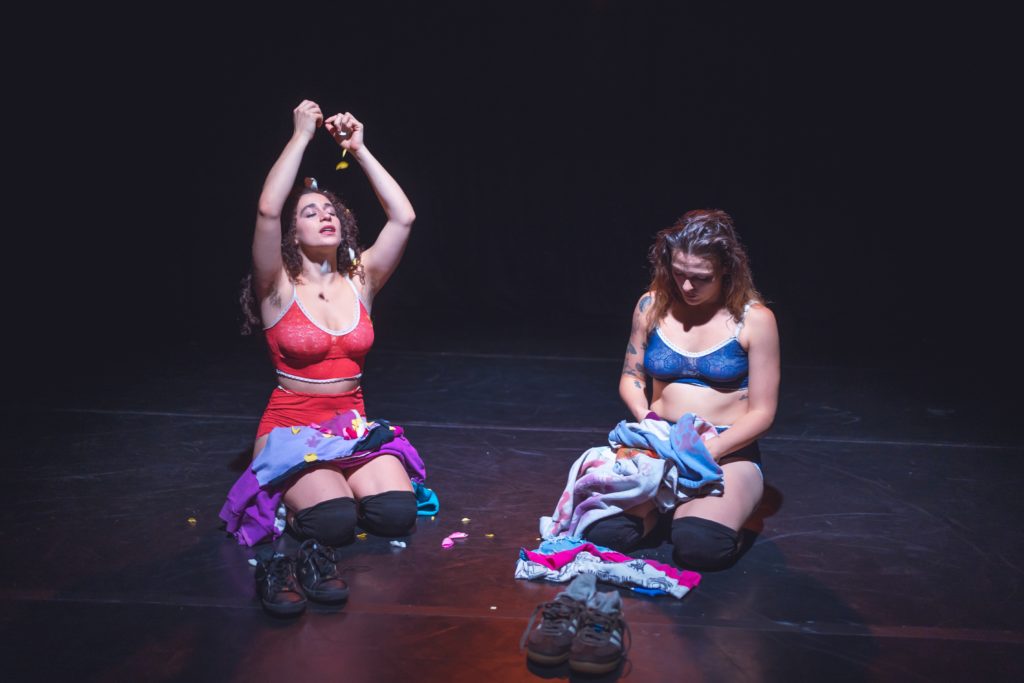Words by Stella Rousham.
Content Warning: Sexual assault, eating disorders, trauma and gender
“What does embodiment mean?”
“Why is it important to you?”
These were the opening questions to the Coming Home: Embodiment Tools for Reconnecting – a series of free community workshops curated by Hannah Grace. Sitting in a circle alongside Hannah, qualified Dance Movement Psychotherapist, Dylan Reddish and two other participants, we were gently guided through a series of meditative breathwork, gentle movement and sound tasks. The aim of the workshop, and others that have taken place across London this month, to help people develop the tools to combat disassociation and trauma in their lives, enabling them to “come home” to their bodies.
These workshops followed the staging of SHEDDING SKINS, a duet choreographed and performed by Hannah at Rich Mix earlier this Autumn. Together, the duet and workshop series, coalesce as part of Hannah’s on-going choreographic journey to healing; a journey that is as deeply personal as it is community orientated and accessible. I had the pleasure of interviewing Hannah, alongside her fellow co-performer, Jacquelyn Tepper, Dramaturg, Léa Tirabasso and Rehearsal Director, Bethany Edwards.
Born in a moment of meditative reflection, Hannah explains how the SHEDDING SKINS duet came to her as an almost “fully-formed vision”. Intially conceptualised as a “fuck patriarchy” piece, for Hannah, the duet represents an embodied and choreographed attempt to reclaim her body. Following the trauma of experiencing sexual assault as an infant, Hannah shares honestly how throughout her adolescence and young adulthood, her body had been trapped in a dissociative state. “I had never experienced pleasure in my body; like enjoying my senses, eating things for fun, or just being able to relax. My nervous system was incredibly dysregulated.” Reflecting on her struggles with disordered eating, Hannah articulates how her detachment from her body and ultimately, self, had been compounded by the social pressures of constant productivity and sexual objectification. From juggling a hectic schedule of dance and fitness, to dating and taking the contraceptive pill, Hannah had a realisation that: “I had to slow my life the F down if I want to actually embody this body”.
After a period of solo research and improvisation, Hannah discovered the movement for the SHEDDING SKINS duet as she found her body “just kept shaking”. The development period with co-performer, Jacquelyn, centred on “filming, reviewing and discussing” this shaking. Where did the shake come from? What speed was it? How did it relate to other dance styles such as Krump or Tap? How can a shake be maintained without becoming dull for the audience or overly strenuous for the performers? Refining and tapping into the different qualities and technicalities of the “shake” was challenging, as Jacquelyn pointed out, “you’re not taught how to shake in dance school”.

Whilst SHEDDING SKINS is deeply personal and cathartic for both Hannah and Jacquelyn, Rehearsal Director, Bethany, recalls how the movement in SHEDDING SKINS is distinct as it is “creating story”, rather than seeking to tell a pre-conceived or chronological narrative. The movement and performance, then, is witness to an embodied journey of healing and transformation. For Jacquelyn, it is this act of witnessing and sharing a personal journey stage which makes the piece universal, as “another person’s vulnerability becomes a lens for yourself”. What I found the most moving and unique about this duet, was the constantly shifting relationship between the two dancers on stage, testament to their exceptional performance and movement quality. The dancers appeared to be in a continual tussle of antagonism and harmony, togetherness and separation, freedom and constraint. This tussle between the dancers was deftly communicated through both the movement and costumes. Clad in baggy sport shorts, cropped hoodies and knee pads, the dancers seemed torn between conditioned embodiment, represented through sexualised poses (whining waists, jutting hips) and workout sequences (squats, running, plies, crawling, burpees), and free or authentic movement, characterised through an all-consuming, eruptive shake and a slow “shedding” of their costumes to their underwear.
As much as SHEDDING SKINS is a movement-based duet, sound and song were also integral to tracing and embodying healing. The opening of the performance reminded me of a cabaret act – the two dancers stood back to back with their arms looped through each other whilst stepping in a circular formation. All the while, they chimed in hauntingly sweet tones lyrics of violence and sexual trauma. These lyrics, Hannah tells me, are taken from an album by American singer-song writer, Fiona Apple, who she was drawn to for her equally “genius” and “weird” content. I appreciate how singing and use of sound in the duet also had a thoughtful link to the healing workshops. One of the final tasks we participated in involved humming as a group, tapping into the sounds and vibrations to seek moments harmony and dissonance. This sound task particularly resonated with me; I felt energised by the coincidental points of harmony and empowered when deciding to create dissonance by changing key.

Considering the emotionally honest and raw nature of the duet, I was interested in how Hannah and her creative team navigated the ethical and psychological complexities of staging trauma-related content on stage. Whilst being incredibly attentive to ensure that the necessary content warnings and resources were available to audience members, Hannah pointed out the “liberating and cathartic” potential of sharing vulnerable experiences on stage. For Hannah, “triggers are not necessarily bad” if it allows audience members to “process emotions that they’ve dissociated from”. Dramaturg, Léa, further remarked that it is the “structure of the work which saves the performance”, ensuring that the audience are “held” and “contained in safe space”. Feeling “held” certainly resonated with my experience as an audience member. In the closing sequence of the duet, the two dancers chanted “on and on we go” whilst undoing their braids and showering themselves in flower petals, before laying their head to rest on the floor. For me, this ending was both soothing and hopeful, allowing me to sit with and register the visceral emotions of the work, without being left entirely drained or despondent.
It is this intention to “choreograph aftercare” – as Jacquelyn put it – which links the SHEDDING SKINS duet to the Coming Home workshops which took place earlier this month. Designed by a diverse range of expert practitioners –psychotherapists, sexual violence advocates, activists and trained counsellors – these workshops aimed to provide a free and accessible route into the intersecting worlds of dance and holistic healing. As Hannah explains, “sometimes dance can be a difficult art form for people to connect with, especially when you’re dissociated […] I really like the idea of giving people this connection and invitation into the dance world.” Attending the workshop, I immediately felt this welcoming invitation. Despite the fact I had never met the other participants, I was struck by how Hannah and her team were able to create such a warm space of trust and solidarity. Whilst Hannah and Dylan did lead the session, they equally contributed to the discussions and activities, which was effective for breaking down any hierarchies or fears of judgement in the space. In a post-pandemic Britain, not only are trauma and PTSD predicated to continue to affect to the physical and cognitive wellbeing of young people, accessing effective support through the NHS is increasingly challenging, with long waiting lists, a lack of staff and closure of mental health services. The ethos of SHEDDINGS SKINS and the Coming Home workshops are more salient than ever, offering an exciting vision of a what a society built with a holistic approach to care and healing could look like.
If you are interested in attending a Coming Home workshop, Hannah and the team will be running one more session in November. Make sure to follow their Instagram for updates and to sign-up for the workshop. Check out Hannah Grace’s website: https://hannahdancing.co/shedding-skins to catch the next SHEDDING SKINS performance.
